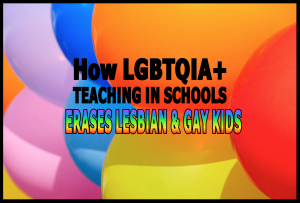
Celebrating diversity is a good thing. Who we love, what we want to wear, whether we like climbing the highest mountains or doing crossword puzzles in front of a warm fire, we are all different. We have dark skin, fair skin, tightly curled hair, straight hair. Some of us are tall, some short, some rotund, some slender. Some of us are born with congenital diseases, some of us are born with physical disabilities. Human beings are part of a wonderful melting pot of differences. Some of us live long; some die young. We love, we suffer and we wonder.
Before I get to schools, there’s a bit of background to cover.
A bit of Biology concerning sexual reproduction
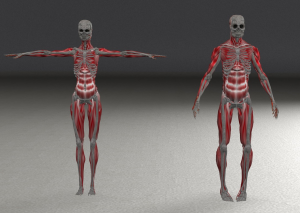
Female and male anatomy looks something like this, although it isn’t necessary to hold your arms in the positions here depicted.
There’s another thing that’s important about humans. We are so much more complex than it alone, but it is the reason I am able to write this and you are able to read it. Humans are a species that has two sexes and reproduces sexually. Not all of us want or are able to reproduce – the world would be more sustainable if fewer of us did – but every one of us on earth today is here because of an unbroken chain of sexual reproduction, where sperm met egg and the result passed successfully through the stages of embryo, foetus and, eventually, baby.
Men produce sperm. Women produce eggs, menstruate, gestate and give birth to the young of the species.
I write about this in more depth here.
Drs Emma Hilton & Colin Wright write about it far better than I ever could, here.
While some people fall on the nature side of the ‘gender’ debate and others on the nurture side, there are some generalisations that we can make, with caution.
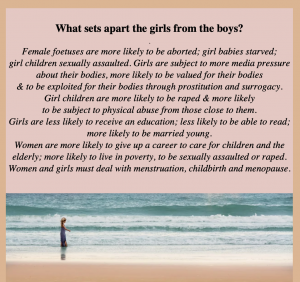 Hormone levels mean that MOST men are more aggressive, stronger and larger than MOST women. This does not mean that an aggressive, strong and tall woman is actually a man.
Hormone levels mean that MOST men are more aggressive, stronger and larger than MOST women. This does not mean that an aggressive, strong and tall woman is actually a man.
Hormone levels mean that MOST women are less aggressive, physically weaker and smaller than MOST men. This does not mean that a non-aggressive, physically weak and small man is actually a woman.
A bit of linguistics concerning sexual orientation
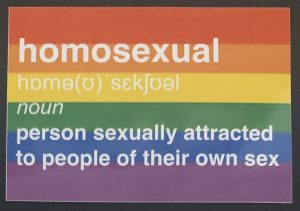 A woman who is sexually attracted to other women is a lesbian.
A woman who is sexually attracted to other women is a lesbian.
A woman or a man who is sexually attracted to both women and men is bisexual.
A man who is sexually attracted to men is homosexual.
A bit of Geography concerning homophobia
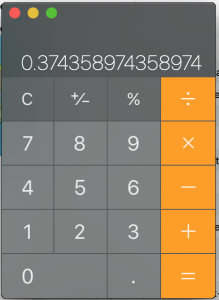 Because these groups, especially the first and last, do not usually perform heteronormativity, they are often discriminated against. Homosexuality is still a capital punishment in ten countries.
Because these groups, especially the first and last, do not usually perform heteronormativity, they are often discriminated against. Homosexuality is still a capital punishment in ten countries.
The website Erasing76Crimes reports that here are 73 countries globally with laws against homosexuality. If there are 195 countries in the world, that makes up over a third of the world.
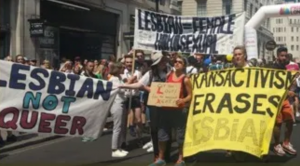
Protestors from ‘Get the L Out’ march at London Pride 2018.
In Iran, for example, lesbian and gay people cannot live openly and are often pushed to transition so as to better perform heteronormativity. One young woman reports that if police checked her ID they would reproach her. “Why are you like this?” they would say. “Go and change your gender.” Eventually she took hormones for seven years, before detransitioning when faced with the prospect of surgery.
“I got to know myself better” she told the BBC. “I accepted that I was a lesbian and I was happy with that.”
While there are no European countries left with specific laws against being homosexual there’s still a long way to go. The continued use of the word ‘gay’ to describe something useless, weak or rubbish springs to mind. The lack of lesbian representation in the media is another issue. It vitally important that same-sex attracted people are able to have the words to describe themselves so that these injustices and imbalances can be recognised.
Why is gender identity politics a threat to the idea of same-sex attraction?
If we accept the idea that it is our gender identity that decides if we are a man or a woman, the meanings of the words we use change. This has massive implications for women’s rights, but here we’re focusing specifically on how it affects the words LGB people are allowed to use to describe themselves.
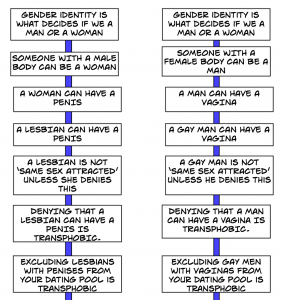
The diagrams above show the chain of events that leads to the demonisation of same-sex attraction.
Lesbians are far more affected by this linguistic shift than gay men. As has been noted wryly many places before, transmen make the news when they have babies, and rarely otherwise. Transwomen make the news for sporting achievements, performing femininity and involvement in politics. We are living in the Upside Down. Why? Because the combination of biology and inherent sexism in our society continues to benefit men, however they might choose to identify. So log on to a lesbian dating app these days, so I’m told, and you’ll find plenty of bepenised persons, aka men, claiming to be lesbians.
A bit of gay history
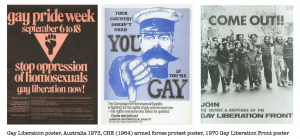
In the UK, the Campaign for Homosexual Equality was established in 1964. In 1967 the Sexual Offences Act decriminalised sex between men, if both were over 21 and not in the Army or Navy. In In 1984 the GLC published ‘Changing the World: A London Charter for Gay and Lesbian Rights’.
The first written homophobia (as far as I know) is that chirpy chappie Leviticus, who decrees: ‘Thou shalt not lie with mankind, as with womankind: it is abomination.” Various other translations call it forbidden, detestable, you get the picture. The persecution of lesbians and gay men mostly stems from this teaching. While the church considered sex to be a sin, ‘straight’ sex produced kiddies to work in the fields of feudal societies and was encouraged within marriage. Among the numerous people burned as witches, somewhere between 80-95% were women and many were lesbians. It has been suggested that the term ‘faggot’ comes from the small pieces of wood used to kindle the fires at these burnings, where gay men were also killed. In 1533, Church law became common law and ‘buggery’ became illegal, punishable by death. The 1800s developed ‘inversion theory’, the idea that gay people are born with a female body and a male mind or vice versa; hence, gay people are “sick”in the medical sense of the word. The novelist Catulle Mendes believed that lesbianism led to “drug addiction, fever, child desertion, husband abandonment, and orgies”. In 1928 the Home Secretary ordered any discovered copies of Radclyffe Hall’s ‘The Well of Loneliness‘ to be burned. Female writers often had to use male names to get their work published. Then Freud popped up, declaring that homosexuality was because of troubled childhoods, not biology, and could be ‘cured’.
All this and more is covered in the fascinating Lavender Papers of the 70s.
Dispelling the idea that there is something implicitly ‘wrong’ with lesbian and gay people was at the heart of the gay liberation movement.
What we now call LGBT History Month was first celebrated in the UK in 2005, organised by ‘Schools OUT’ (which began life as The Gay Teachers Association in 1974). Before the turn of the century there was little or no mention of the T being attached to the LGB.
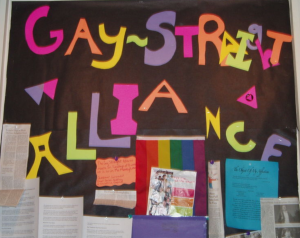 The Gay/Straight Alliance, founded in the USA in the 1980s has now been rebranded as the ‘Gender/Sexuality Alliance‘. Conveniently the acronym remains the same.
The Gay/Straight Alliance, founded in the USA in the 1980s has now been rebranded as the ‘Gender/Sexuality Alliance‘. Conveniently the acronym remains the same.
In the UK, the LGB Alliance is frequently misrepresented as a hate group for not including the T.
But it hasn’t always been this way.
In the 1999 proclamation 7203 the then President of the USA declared ‘ I, William J Clinton, President of the United States of America, by virtue of the authority vested in me by the Constitution and laws of the United States, do hereby proclaim June 1999 as Gay and Lesbian Pride Month.‘
It was in 2009 that Barack Obama extended the name to ‘Lesbian, Gay, Bisexual and Transgender (LGBT) Pride Month’.
The American Library of Congress now refers to it as ‘Lesbian, Gay, Bisexual, Trans and Queer Pride Month’.
The broader the umbrella, the less it means. Are you straight? Did you once snog a bisexual person? Yay, you can call yourself ‘queer’ if you like. After all, it’s up to you how you identify! The events at Stonewall have been rewritten. Men and women who rejected gender are posthumously rebranded as transgender.
If you search ‘LGB’ online now, your first hit will now be an advert for model railways. Children are no longer taught about the fight for people to be accepted and allowed to lead regular lives whatever their sexuality. It is as if the history of the entire LGB culture before the T was tacked on has somehow been wiped away. As far as a quick Google search goes, it is as if it never existed.

The exception to this, although recently formed, is the LGB Alliance, whose tweets and website do come up in a Google search. The first hit is their twitter account – the second an article in the Independent, headlined ‘LGB Alliance’ group faces criticism for being transphobic’ and sublined, ‘I am utterly disgusted at your attacks on our trans siblings’.
What do these ‘attacks’ entail? Standing up for the rights of those who are same-sex attracted.
There must be no LGB without the T.
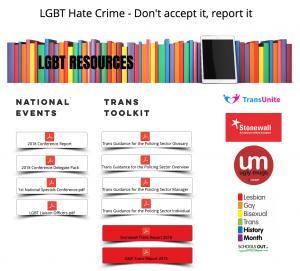
LGBT Police Resources on hate crime provide a number of trans toolkits, as you can see on the left – but they provide absolutely nothing for lesbian, gay or bisexual people, leading the LGB Alliance to comment, “we’re having difficulty finding the lesbian toolkits & the gay & bisexual toolkits. We are sure you must be dividing these resources fairly between the LGB and the T, but we’re having trouble locating these other toolkits. Please give us the link.”
Of course, there is no link.
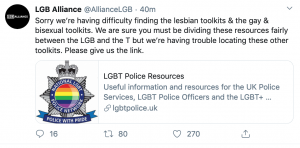
 In this recent tweet, we see Stonewall offering to pay trans-identified people for their tales of experiencing ‘hate crime’. It is unclear why they feel the need to pay people, or even what they mean by ‘hate crime’. In some circumstances young people are told that being ‘misgendered’ is a hate crime.
In this recent tweet, we see Stonewall offering to pay trans-identified people for their tales of experiencing ‘hate crime’. It is unclear why they feel the need to pay people, or even what they mean by ‘hate crime’. In some circumstances young people are told that being ‘misgendered’ is a hate crime.

Where does this leave lesbian and gay young people?
If I type LGB into Wikipedia, I am offered a number of options. A college campus, an airport in California. A laser-guided bomb, no less.
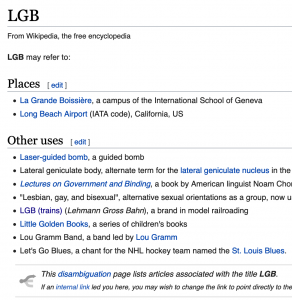
Sixth on the list is LGB, but there’s nothing to click on. Instead, the reader is directed to the wiki entry on LGBT.
![]()

Even auto correct in this article doesn’t like it, and marks it with a red dotted line. Perhaps claiming erasure at this point is not entirely unreasonable?
How did we get here?
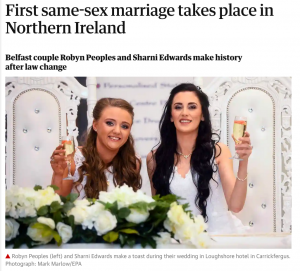 The first legal UK same-sex marriages took place in England and Wales in 2014 and in Scotland a few months later. The first in Northern Ireland took place earlier this month, in February 2020.
The first legal UK same-sex marriages took place in England and Wales in 2014 and in Scotland a few months later. The first in Northern Ireland took place earlier this month, in February 2020.
Stonewall, the UK’s predominant LGB support group, did not embrace the T until 2015, after same-sex marriage became legal in Great Britain. Some suggest that the adoption of the campaign for ‘trans rights’ developed because there were no more legal milestones to break for LGB rights.
In 2015 the Guardian reported, “Britain’s biggest campaigner for lesbian and gay rights, Stonewall, has announced that it will also start working for trans equality, describing the move as a significant moment and apologising for its past failure to do so.”
Ruth Hunt made this somewhat cryptic statement:
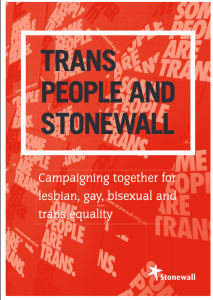 “Our campaigners approached sexual orientation and gender identity as separate issues. This distinction meant greater social progress was achieved for all of us. Today, society has moved on and Stonewall no longer needs to maintain a strict distinction between sexual orientation and gender identity. Historically, we thought it was the right thing to do.”
“Our campaigners approached sexual orientation and gender identity as separate issues. This distinction meant greater social progress was achieved for all of us. Today, society has moved on and Stonewall no longer needs to maintain a strict distinction between sexual orientation and gender identity. Historically, we thought it was the right thing to do.”
From then onwards, gender identity was the bomb.
So why is this a problem? Everyone deserves rights, right? Obviously. But what happens when those rights trample on the rights of other groups?

Now we are expected to say we believe that we all have gendered brains; that there are man brains and woman brains and we all intrinsically know which one we’ve got via some inner essence of gender.
Some find the words to express this gender identity at aged just two; others may not realise until they are sixty. If and when they say it is so, it is so, and to deny it is tantamount to conversion therapy. To deny that trans-identified people, including children, were born into a wrongly sexed body is an act of transphobia, a hateful act designed to erase the person who believed it. To complicate things further, some people are non-binary, neither men nor women, neither girl nor boy. Others are gender fluid, a man some days, a woman others. You can read about award winning financier and public speaker Pips Bunce, here.
Sounds unlikely?
I’ve written about Gendered Intelligence, Allsorts and Mermaids elsewhere on this blog.
Perhaps, after Mermaids visited your child’s school and told them some girls that liked boy stuff were actually born in the wrong body, your tutu-wearing, Frozen-loving son told you he thought he might be a girl? Maybe your rough-and-tumble daughter thinks perhaps she’s non-binary?
You’re concerned. You find an article on the NHS ‘patient info’ websites, where you book appointments with your doctor.
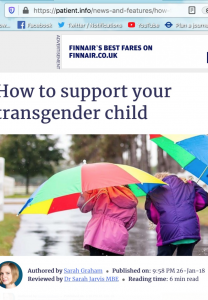 “Some years ago, at a young age, our daughter first told us they were a girl. This was quite a shock at the time, as we’d thought they were born male. It turned out we were mistaken,” writes a transactivist parent in an article entitled ‘How to Support Your Transgender Child’.
“Some years ago, at a young age, our daughter first told us they were a girl. This was quite a shock at the time, as we’d thought they were born male. It turned out we were mistaken,” writes a transactivist parent in an article entitled ‘How to Support Your Transgender Child’.
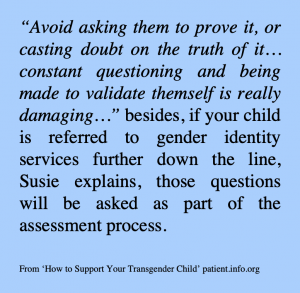 Later in the article, Susie Green, CEO of Mermaids, who took her 16 year old abroad for ‘gender reassignment’ surgery (having the penis removed and made into a ‘vagina’) advises parents not to ask their child too many questions if they say they are transgender.
Later in the article, Susie Green, CEO of Mermaids, who took her 16 year old abroad for ‘gender reassignment’ surgery (having the penis removed and made into a ‘vagina’) advises parents not to ask their child too many questions if they say they are transgender.
Synopsis: a parent who is concerned because their son says ‘I’m a girl’ and goes to an NHS site for advice will be told two things.
Firstly, that a boy can actually be a girl.
Secondly, that they should not suggest to their confused son that he is wrong, that he is not a girl. If your daughter says she is a boy then you must believe her. You thought she was born female. You were mistaken.
Note that the advice does not come from doctors, it comes from parents who have transitioned their own children- laypeople with no medical training. There is no scientific evidence to suggest that it is possible to have a ‘girl’ brain in a ‘boy’ body, or vice versa. How could a girl brain even be defined? By a love of all things pink, a sensitive heart and a penchant for pretty jewellery?
How long will it be before we are advised that a girl who loves short hair, football and mud is actually a boy? Who will be setting the critera; who will be assigning genders in the future?

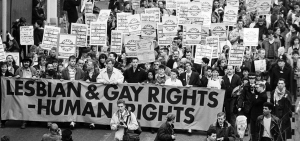
Protesting Clause 28: If you were to go on a protest carrying a banner like this one in 2020 you would be accused of transphobia.
So what happened?
 THE 80s were the years of ‘gender bending’ but nobody suggested that ‘man’ or ‘woman’ were vague elusive ideas inside our heads.
THE 80s were the years of ‘gender bending’ but nobody suggested that ‘man’ or ‘woman’ were vague elusive ideas inside our heads.
So why now? What has changed?
If we think about it, is it really likely that young people have suddenly ‘found the words’ they were missing for hundreds, if not thousands, of years? If gender identity is such a vast part of our beings, why has it taken until this point in human history for anyone to start talking about it?
Education can be a great thing. While my school was ahead of its time for tolerance (long haired boys were quite the norm & the headmaster coached us into London for CND protests) I don’t remember any teachers in school discussing same-sex attraction beyond a vague and somewhat unconvincing, ‘there’s nothing wrong with it really‘. Fourteen year old me could perhaps have been spared a lot of sleepless nights had she ever read about, or heard an adult talk about, how it was ok to be bisexual.
Pride, of course, is a commercial enterprise in the 21st century, with rainbow clothing being sold in branches of Primark, and Macdonalds hanging bunches of rainbow balloons outside their stores along the route of Pride marches. Sky, Barclays, H&M, Nike, Adidas and numerous other companies have also jumped onboard and are now quick to show their support for LGBTQ+ rights, although their investments and choice of business partners suggest this may be about as genuine as the oil company Shell’s claim that it uses “waste CO2 to grow flowers and waste sulphur to make concrete”. H&M for example, has a manufacturing factory in China, a country with an abysmal record on gay rights.

The idea that being gay could be celebrated by a mainstream organisation like the Post Office (the ‘Royal Mail’ back then) would have been inconceivable back in the 80s. But where does the idea that we are attracted to gender not sex really leave the L and the G of the LGBTQIA+ culture?
Let’s have a look at what actually happens when the idea of same-sex attraction becomes problematic. Let’s look at gender identity teaching in schools.
Specifically- at last! – let’s look at the LGBT History month schools packs, which schools are encouraged to use as a resource to teach their pupils about LGBTQIA+ issues.
LGBTQ+ History Month Schools Packs
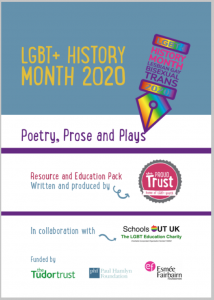
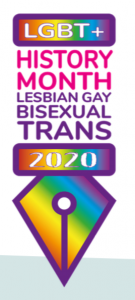 In the current climate, I approached the schools packs for LGBT History month with some trepidation, and it turns out that was not unfounded. The pack is written and produced by ‘The Proud Trust‘, which believes intersex to be an identity and describes itself as a ‘lifesaving organisation‘. The logo is synonymous with what is to come inside: designed in such a way that the LG is swallowed up, the B fares slightly better, but it’s actually all about the T. This is a pretty good estimation of the message inside.
In the current climate, I approached the schools packs for LGBT History month with some trepidation, and it turns out that was not unfounded. The pack is written and produced by ‘The Proud Trust‘, which believes intersex to be an identity and describes itself as a ‘lifesaving organisation‘. The logo is synonymous with what is to come inside: designed in such a way that the LG is swallowed up, the B fares slightly better, but it’s actually all about the T. This is a pretty good estimation of the message inside.
The pack tells students that LGBT+ History month has been celebrated ‘every February since 2005’.
It starts off well enough, with a foreword by Sarah Canning, partner of murdered journalist Lyra McKee, who hopes that “different sexualities, gender expressions and identities will not just be accepted, but celebrated”.
The introduction is written by Sue Sanders who points out that many authors are LGBTQ and that this knowledge is “vital to students who are questioning and exploring their sexual orientation and/or gender identity”.
But there are problems with both these statements, because the words ‘sexual’ and ‘sexuality’ work on the principle that all human beings have a sex, and that we are attracted to others because of, or despite, their sex. Either way, sex is important, not just the act but the definition.
One of the better sections of the pack deals with part of Lyra Mckee’s moving ‘letter to my 14 year old self‘ and encourages kids to write a letter of their own to a real or hypothetical LGBT person. This could certainly be a positive activity, but as one reader put it “Five paragraphs about Lyra and the word lesbian isn’t mentioned once.”
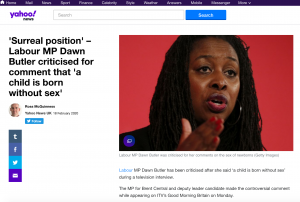 Queer politics questions the importance of the definition of sex. We are now told that babies are ‘assigned a sex at birth’ and that it is something a child can ‘choose’ as they get older. Even as we are told that sex and gender are different, we are told in the same breath that they are one and the same thing.
Queer politics questions the importance of the definition of sex. We are now told that babies are ‘assigned a sex at birth’ and that it is something a child can ‘choose’ as they get older. Even as we are told that sex and gender are different, we are told in the same breath that they are one and the same thing.
Recently I attended a meeting called ‘What if the State no Longer Sexed Us?’ After the meeting I spoke to the speakers and not one of them could give me a clear definition of the difference between sex and gender- or even a definition of ‘sex’ and ‘gender’. One said that they were ‘the same thing really’; another avoided answering the question all together.
These people held an hour long meeting discussing the importance of sex and gender without making any attempt to define the words.
Just a few days ago, Labour party member and deputy leader hopeful Dawn Butler told the world via prime time telly “the child is born without sex in the beginning”.
As we move past the introduction to the schools’ pack, the problems that arise because of this become clear.
The headline of session one promises, “In this lesson you will learn some of the most common words that people use to describe their sexual orientation and gender identity.”
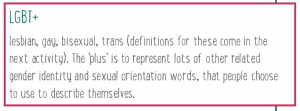
Thank goodness the definitions of those ‘gender identity and sexual orientation words‘ are coming. That’ll clear things up. Here we go.
‘What do we mean by the term ‘sexual orientation?’. Simple.

Wait… what? Sexual orientation describes a type of person? Like goths and punks? No, hang on, part of your identity describes who you fancy? I’m so confused.
Let’s have a look at the term ‘gender identity’ instead.

Gender identity is how a person ‘knows themselves to be‘. A person might identify as a woman, man, both, neither or in another way.
How easy do you imagine it is for young people to question this? And perhaps more importantly, how likely is it that those confused by the woowoo in the sentences above would dare ask for things to be explained more clearly?
The teacher is next told to ‘hand out the LGBT+ Terminology Anagram sheets‘ and ask students to ‘work through the sheet to unscramble the LGBT+ identity terms‘.
Good luck with that, kids.
To spare you the utter mindfuck of wading through the anagrams, dear reader, I here provide you with the teachers’ answer sheet to the ‘sexual orientation’ anagrams.
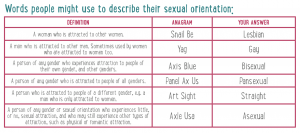
Don’t forget that sexual orientation is ‘the part of a person’s identity that describes the types of people that they are attracted to, or fancy’. Also, bear in mind that gender identity means that ‘a person might identify as a woman, a man, as both, as neither, or in another way.’
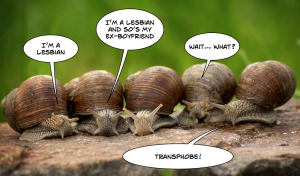 So, as the students re-arrange the letters of ‘snail be‘ to form the word ‘lesbian’, the more diligent among them will realise that the phrase ‘a woman who is attracted to other women’ can mean absolutely anything. It can mean a girl who is attracted to another girl, but it can also mean a girl who is attracted to a boy who identifies as a girl, or even describe two boys who identify as girls who are attracted to each other.
So, as the students re-arrange the letters of ‘snail be‘ to form the word ‘lesbian’, the more diligent among them will realise that the phrase ‘a woman who is attracted to other women’ can mean absolutely anything. It can mean a girl who is attracted to another girl, but it can also mean a girl who is attracted to a boy who identifies as a girl, or even describe two boys who identify as girls who are attracted to each other.
And remember – to question this is transphobic.
A bisexual person is ‘a person of any gender who experiences attraction to people of their own gender, and other genders’.
A pansexual person is ‘a person of any gender who is attracted to people of all genders.’
Can you tell the difference? Would fourteen year old you have dared ask for a clearer explanation. No? Me neither. Remember, if you think that you might have done, that these kids have had it drummed into them that if you question somebody’s trans identity they are likely to kill themselves. You’re not just going to annoy your teacher and possibly piss off your classmates if you ask questions – you may be LITERALLY responsible for someone killing themselves. ‘Bisexual’ is a bit problematic anyway, suggesting as it does that the sexes exist and that there are two of them. Far cooler to be ‘pan’.
Questions? No, I didn’t think so. Pay attention. There’s more.
A person who is attracted to people of a different gender, e.g. a man who is only attracted to women is called ‘straight’. But hang on, even this is problematic. How do you know someone’s gender identity before you’re attracted to them? How does a boy know he’s gay if he doesn’t know how the boy he fancies identifies?
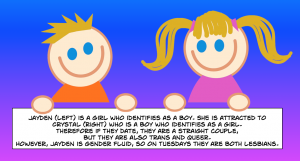
This cartoon is not from the workbook but perhaps it should be.
“Explain to the young people,” continues the pack, “that there can often be challenges to liberation movements, most often by people who do not have the identities that the movement is seeking equality and justice for (e.g., men who challenge equality for women, or cis people who challenge equality for trans people)”
But wait – the word woman doesn’t really mean anything specific. What do women call ourselves when the word ‘woman’ is taken away from us? If you can’t define what a woman is, how do you define equality for women? How do we get equality and justice when the oppressed can no longer name themselves?
What exactly is meant by ‘trans rights’?
Some people believe that our sexed bodies have gendered souls. When a female soul, or essence, is put into a male body (or vice versa) that person is transgender.
Not everyone believes this is possible. Atheists, for example, have to be capable of pretty impressive cognitive dissonance to balance the ‘gendered souls/ there’s no creator’ dichotomy. If we have gendered souls, who is putting them into our bodies? And, if it doesn’t happen like that, how could a female brain possibly grow in a male body?

Is there a definition of ‘trans rights’ that isn’t based on enforced mass acceptance of this idea that our sexed bodies have gendered souls?
Equality is not about forcing others to hold your beliefs. To claim that anyone who disagrees with you is a hateful bigot- who needs to be ‘educated’ until they do agree- is unreasonable at best, tyrannical at worst. The current idea of ‘trans rights’ demands that everybody must accept that a man who says he’s a woman actually IS a woman because he has a womanly essence.
‘Trans rights’ means the right of trans people to demand that others believe this.
But that isn’t a right. You don’t have the right to demand that other people believe the same things you do. The idea certainly has little to do with equality and justice.
After those activities, teachers are told to remind children of the support ‘you and your pastoral team’ can offer, and advised to direct kids to the Proud Trust map.
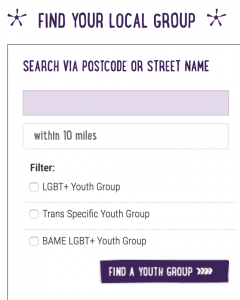 This is an interactive map where young people can find an LGBT group close to them.
This is an interactive map where young people can find an LGBT group close to them.
There are LGBT+ groups, BAME LGBT+ groups and there are ‘trans specific’ groups.
There are no groups listed where young people can meet and talk specifically about being same-SEX attracted. There are no LGB groups, because – remember – wanting an independent LGB group is transphobic. And transphobia kills.
The pack also contains links to PROUD guides for LGBT youth which, to be fair, contain some good advice about eating properly, exercising and forming positive relationships amidst the woowoo.
One such, the ‘Connected Young Men’s Guide to Hope‘ reminds young men that ‘LGBT+ people are like the sun, they give you warmth, light and life’ also that ‘the oceans existed before they were named and so did your gender’ and reminds them to ‘take your prescribed medication’.
The ‘Sex & Relationships Guide for Young Women’ describes a lesbian as ‘someone who identifies as a woman and is usually only attracted to other women’.
Another, the ‘Faith in Yourself‘ mini guide for religious young people, describes ‘gay’ as: “A person who is emotionally, romantically, and/or physically attracted to people of the same gender.”
What does this even mean?
 Teachers are provided with a worksheet on which students have to identify who fits in to which facet of LGBT. In the illustrious company of icons like Sappho, Shakespeare, Audre Lorde and Carol Ann Duffy, we find Alok Vaid-Menon, he who considers himself to be ‘non-binary trans-feminine’ and once said little girls were not ‘pure, innocent victims‘ but could be ‘kinky, deviant and mean‘.
Teachers are provided with a worksheet on which students have to identify who fits in to which facet of LGBT. In the illustrious company of icons like Sappho, Shakespeare, Audre Lorde and Carol Ann Duffy, we find Alok Vaid-Menon, he who considers himself to be ‘non-binary trans-feminine’ and once said little girls were not ‘pure, innocent victims‘ but could be ‘kinky, deviant and mean‘.
How does he know this? Because, he tells us, he was once himself ‘a cute little girl’.
An excellent role model for gay kids.
Straight kids are encouraged to be ‘a positive and visible LGBT+ ally’ and told that an ally ‘believes in, and fights for equality for LGBT+ people’, which would be brilliant if it weren’t for the fact that being an LGBT+ ally necessitates- as we have seen above- advocating for the value of gender over sexuality.
A student who complains that LGBT issues are talked about more than racism should be asked, “Is comparing types of discriminations that helpful? Why not use your time to challenge discrimination, rather than debate it?”
Yet in contrast, a student who says LGBT+ is a personal identity and asks why it needs to be talked about so much should be told ‘straight and cisgender people are represented everywhere, we see, read and talk about them all the time.’

The final suggested activity is getting students to ‘queer’ a fairytale. It’s suggested that they may want to produce this as an alternative Christmas play.
The Proud Trust tweets that the sample story they’re encouraged to ‘queer’ is Cinderella: in fact it is Rapunzel.
It seem that even they can’t bear to examine their own resources too carefully.

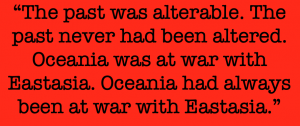
Leviticus is probably _not_ the source of being anti-gay. IIRC verses in one of the two(?) books of Corinthians is where St Paul(?) suggests that early male Christians were damaging the new Christian community by fancying each other rather than concentrating on loving Jesus. St Paul was thus cautious of both hetero and homo relationships. 🙂 (But that was back in a Religious Instruction class in Ireland around 1955, for me).
Thank you! That’s very interesting. My source was the Lavender papers, which I link to in the article, I’m unsure which order the books are in the Bible. I expect there will have been ‘anti gay’ teachings in other, older religious texts too.
Leviticus is in the Hebrew Scriptures, aka “Old Testament”. It was written a few hundred years earlier than the books of the New Testament– which includes Corinthians. (The Hebrew Scriptures are part of both the Jewish *and* Christian canon. The New Testament is all the Jesus/Christian stuff, that comes after what Christians call the Old Testament.)
Hi I noticed you attended the “What if the State No longer Sexed us” which I presume is the same meeting I attended run by Davina Cooper at Kings College on the Future of Legal Gender. Did you notice at the talk what she talked about not only wanting to get rid of sex but of wanting to get rid of age as well? I attended two meetings held by her and she mentioned this in both. She is also an advisor on this project with its interesting ‘artwork’. https://opencall.sciencegallery.com/gender Looks to me as if pedophilia is penetrating the highest echelons of academia.